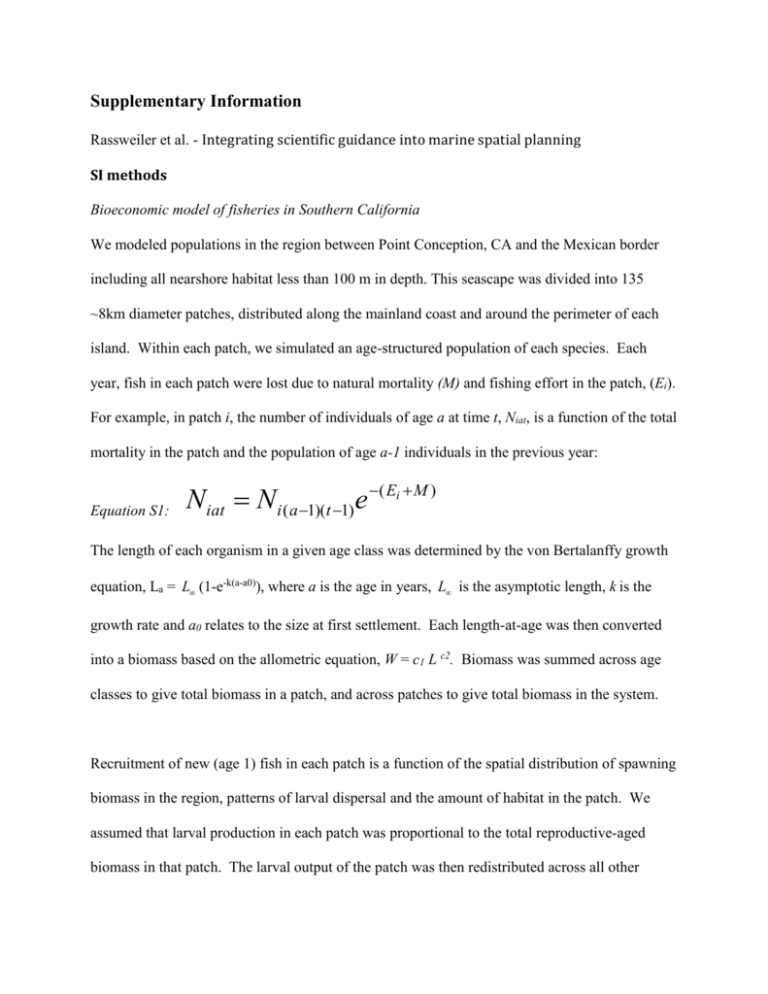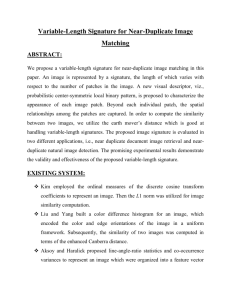Supplementary Methods - Proceedings of the Royal Society B
advertisement

Supplementary Information Rassweiler et al. - Integrating scientific guidance into marine spatial planning SI methods Bioeconomic model of fisheries in Southern California We modeled populations in the region between Point Conception, CA and the Mexican border including all nearshore habitat less than 100 m in depth. This seascape was divided into 135 ~8km diameter patches, distributed along the mainland coast and around the perimeter of each island. Within each patch, we simulated an age-structured population of each species. Each year, fish in each patch were lost due to natural mortality (M) and fishing effort in the patch, (Ei). For example, in patch i, the number of individuals of age a at time t, Niat, is a function of the total mortality in the patch and the population of age a-1 individuals in the previous year: Equation S1: Niat Ni ( a 1)(t 1) e ( Ei M ) The length of each organism in a given age class was determined by the von Bertalanffy growth equation, La = L (1-e-k(a-a0)), where a is the age in years, L is the asymptotic length, k is the growth rate and a0 relates to the size at first settlement. Each length-at-age was then converted into a biomass based on the allometric equation, W = c1 L c2. Biomass was summed across age classes to give total biomass in a patch, and across patches to give total biomass in the system. Recruitment of new (age 1) fish in each patch is a function of the spatial distribution of spawning biomass in the region, patterns of larval dispersal and the amount of habitat in the patch. We assumed that larval production in each patch was proportional to the total reproductive-aged biomass in that patch. The larval output of the patch was then redistributed across all other patches based on a set of dispersal probabilities (Dij) that represent the probability of a larvae originating at location i being transported to location j by ocean currents (1),(2). Populations in this model were regulated by density-dependent survival occurring between settlement and recruitment into the adult population, as is common for benthic fish and invertebrates. The relationship between the number of age-1 individuals recruiting in patch i at time t, Ni1t, and the number of settling larvae arriving in the patch in the previous year, Si(t-1), follows a BevertonHolt function, with representing the maximum settler survival rate and i relating to the maximum number of recruits possible in the patch: 1 Equation S2: 𝑁𝑖1𝑡 = 𝑆𝑖(𝑡−1) 𝛼 1+𝑆𝑖(𝑡−1) 𝛽𝑖 i sets the maximum recruitment in a location and thus the carrying capacity of that patch. i also varies from patch to patch to reflect the variation in available habitat, with i equal to ∝ R̂𝐻𝑖 , where R̂ represents the maximum recruitment that is possible in a patch containing 1 km2 of suitable habitat and Hi is the amount of suitable habitat in the patch. Jointly α and Rmax set the strength of density dependence as well as the unfished biomass of the whole system. Here we chose and Rmax for each species so that the appropriate density dependence and unfished biomass are achieved. Because we are using the compensation ratio (CR) as our measure of density dependence, and because the CR describes the ratio between the maximum possible larval survival and larval survival in the unfished state, we choose and Rmax to maintain this ratio, while achieving a target unfished biomass. The choice of unfished biomass does not affect the results of this study and so we use 106 for convenience. We simulated the spatial distribution of fishing effort in the model based on a fleet model that assumes that each fisherman seeks to maximize their individual yield-per-unit-effort. We expressed the fishing effort in patch i as the instantaneous mortality rate due to fishing, Ei. Thus, the yield in patch i at any moment in the fishing season is proportional to the fishing effort expended in the patch and the current biomass of legal-sized individuals. The biomass at any point in the season is a predictable function of the biomass of legal-sized individuals in the patch at the beginning of the season, BLi, the natural mortality rate, M, and the mortality rate due to fishing, Ei. Therefore, we can calculate the instantaneous yield at any time and integrate over the season to obtain the annual yield in the patch in year t, Yit, given the effort applied in that patch in that year, Eit: Equation S3: B Lit E it 1 e E it M Yit E it M Fishers avoid patches designated as marine protected areas, but otherwise move among patches until none can improve their yield by reallocating effort to another patch. The biological model and alternative management scenarios were simulated using MATLAB (v. 7.9 © MathWorks 2009). References 1. J. Watson et al., Realized and potential larval connectivity in the Southern California Bight, Mar. Ecol. Prog. Ser. 401, 31–48 (2010). 2. S. Mitarai, D. a. Siegel, J. R. Watson, C. Dong, J. C. McWilliams, Quantifying connectivity in the coastal ocean with application to the Southern California Bight, J. Geophys. Res. 114, C10026, doi:10.1029/2008JC005166. (2009).

![Pumpkin Patch - L2 exam summary questions[1]](http://s3.studylib.net/store/data/006891404_1-eaba8a01ed43ce8c58f5173adc5f257b-300x300.png)


